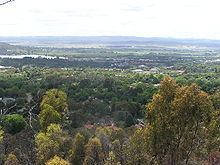Population 1,467 (2011 census) Postcode(s) 2603 Area 157 ha Postal code 2603 | Established 1926 Founded 1926 Gazetted 20 September 1928 | |
 | ||
Forrest (postcode: 2603) is an affluent suburb of Canberra, Australian Capital Territory, Australia. Forrest is named after Sir John Forrest, an explorer, legislator, federalist, premier of Western Australia, and one of the fathers of the Australian Constitution. Streets in Forrest are named after explorers and governors. According to the Australian Bureau of Statistics Forrest is the second most Socio-Economic advantaged location in Australia after the neighbouring suburb of Barton.
Contents
- Map of Forrest ACT 2603 Australia
- Demography
- Education
- Suburb amenities
- Notable places
- Forrest Housing Precinct
- Street furniture
- Forrest Fire Station Precinct
- Tennyson Crescent Christmas lights
- Geology
- References
Map of Forrest ACT 2603, Australia
Forrest is one of the few suburbs in Canberra built to the original Canberra plans. It contains many circular and geometric patterns in its streets and can be quite confusing to drive in. Forrest was renamed from the earlier suburb Blandfordia (the name of the Christmas Bell) and gazetted as a suburb in 1928. South Blandfordia became part of the new suburb of Griffith at the same time.
The original residents of Forrest were mostly senior public servants who were moved from Melbourne.
Demography
In the 2011 Census, the population of Forrest was 1,467, including 3 (0.2%) Indigenous persons and 1,049 (71.5%) Australian-born persons. 55.0% of dwellings were separate houses (compared to the Australian average of 75.6%), 13.2% were semi-detached, row or terrace houses (Australian average: 9.9%) and 31.7% were flats, units or apartments (Australian average: 13.6%). 43.7% of the population were professionals, compared to the Australian average of 21.3%. 15.1% worked in government administration, compared to the Australian average of 1.3% and the Canberra-wide average of 20.1%. The median weekly personal income for people aged 15 years was $1,457, compared to the median Australian income of $577.
Education
Forrest Primary School is situated in Hobart Avenue in Forrest. It caters for students in years P-6. The students wear red and yellow. The school celebrated its fiftieth anniversary on 4 April 2008.
Forrest residents get preference for:
Suburb amenities
The suburb includes part of the Manuka shopping centre. The suburb also contains a government run primary school.
Forrest together with the northern parts of Deakin and Red Hill (sometimes called "old Deakin" and "old Red Hill"), represent the most prestigious residential area in Canberra. Most of the area is detached dwellings in which a 1600 m2 block would be on the small side, and 2000 m² blocks are not atypical.
Notable places
Forrest includes several areas that are listed by the ACT Heritage Council, covering most of the suburb:
Forrest Housing Precinct
The Forrest Housing Precinct is subject to conservation measures to preserve its character. Important values being preserved in the suburb are:
Street furniture
The remnants of street furniture, that is street signs, fire hydrants and footpath lighting and other elements including kerbs and gutters and examples of brick drains, are valued for their contribution to the aesthetic of a twentieth-century 'Garden City' planned subdivision. The furniture of the Garden City precincts (Blandfordia 4 and 5 and the Forrest Housing precincts) is now protected.
Forrest Fire Station Precinct
These buildings are in the block bounded by Canberra Avenue, Empire Circuit, Manuka Circle and Fitzroy Street. They were completed in 1938 and include a former fire station. The buildings are considered important examples of Australian Early Modern Architecture and illustrate a distinctive comparison with the "Federal Capital Architecture" that dominated in Canberra in the 1920s and 30s.
Tennyson Crescent Christmas lights
The Richards' family home in Tennyson Crescent took out the Guinness World Record for the most lights on a residential property on 4 December 2011. Electricity at the house lights more than half a million Christmas lights. The lighting display opened to visitors, with gold coin donations accepted to raise money for SIDS and Kids ACT.
Geology
Mount Painter Volcanics dark grey to green grey dacitic tuff is found in all except the northeast side. There are a few outcrops of sediments in amongst the volcanics containing shale and sandstone. On the northeast a patch of Ordovician Pittman Formation greywacke outcrops along Canberra Avenue. Black Mountain Sandstone is near St Andrew's church in the north north east. Canberra Formation, calcareous shale is found in the north. The Deakin Fault runs from State Circle to Manuka separating the Mount Painter Volcanics from the other sediments.
